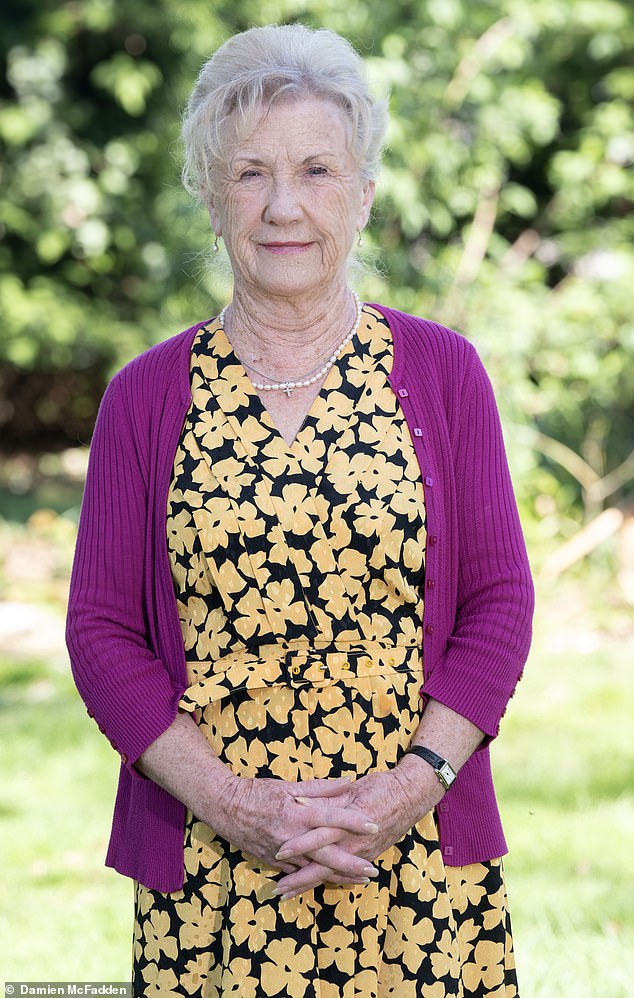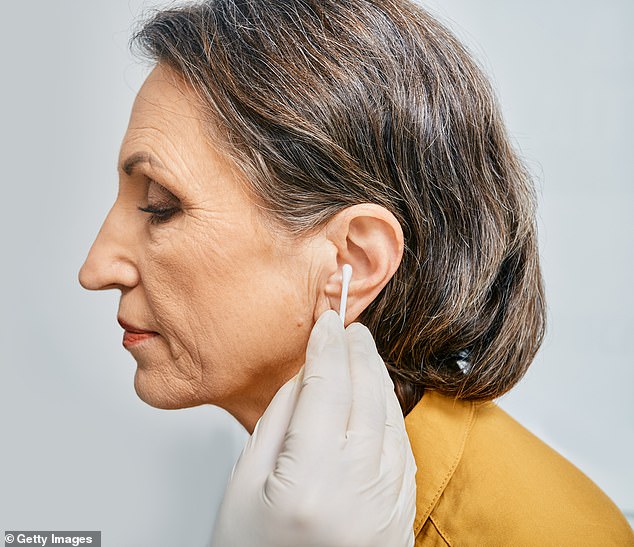For three years Audrey Houghton’s world shrunk: she stopped going to keep fit classes, volunteering – even socialising.
This wasn’t due to physical infirmity or depression: it was all because of a build-up of earwax.
Audrey, like millions of others, suffers with a frequent build-up of excess wax. While for decades her problem was kept at bay by twice yearly visits to the GP to have her ears syringed, in 2022 her doctor – like many in the country – stopped offering the service.
Audrey struggled on, trying to dislodge the wax herself using olive oil to soften it – as is now the direction from the NHS – as well as trying various sprays and a pump that she filled with water. But nothing really worked.
As a result, the earwax built up and impacted her hearing so much that Audrey, 70, a widow and retired school lunchtime supervisor, who lives in Biggleswade, Bedfordshire says: ‘I didn’t like going shopping unless my daughter was with me, because I couldn’t hear what the checkout staff were saying.
‘I had to give up going to church as I couldn’t hear the sermon and stopped the keep fit class I went to as I couldn’t follow the trainer’s instructions.
‘I became very isolated, more and more withdrawn – not going out much at all, as it was so much effort to hear people. It was a depressing time for me.’
Aside from affecting her hearing, the earwax also led to repeated, painful ear infections that required multiple courses of antibiotics.
The Royal National Institute for Deaf People (RNID) charity is now warning there may be millions like Audrey whose mental and physical health is put at risk because they can’t get their earwax removed.

Audrey Houghton, 70, from Biggleswade, stopped exercising and volunteering due to wear wax build-up after her GP stopped providing removal treatments
In a survey conducted this year, out of 2,750 people one in 20 had in desperation used items such as tweezers or hairpins to clear earwax – risking permanent damage to the ear canal – while more than one in ten of them had taken time off work because they couldn’t hear or were in pain.
The charity has now launched a campaign, Stop the Block, calling for earwax removal services to be reinstated on the NHS for everyone who needs it.
Earwax is a natural, oily substance that protects and cleans the ear. It normally works its own way out of the ear, but its passage can be blocked – especially if the ear canal is narrow or if you wear hearing aids.
The RNID estimates around 2.3million people in England alone need their earwax professionally removed, but whether they get it on the NHS is a postcode lottery.
Whereas previously it was readily available on the health service, in recent years whether or not your GP will provide this service is determined by an Integrated Care Boards, organisations that determine which health services are funded locally.
‘It is unacceptable that millions of people across England are still unable to access vital earwax removal services from the NHS in their local area,’ Crystal Rolfe, director of strategy at the RNID, told the Mail.
Under guidance from the National Institute for Health and Care Excellence (NICE), ‘adults with earwax that is contributing to hearing loss or other symptoms – or preventing ear examination or ear canal impressions being taken – should have earwax removed in primary care or community ear care services’.
The guidelines recommend either ear irrigation (flushing the wax out using water via an electronic irrigator) or microsuction (using a miniature vacuum to suck the wax out).
Syringing, which involves delivering water into the ear, is no longer recommended as it can be difficult to control water pressure.

Crystal Wolfe, director of strategy at the Royal National Institute for Deaf People
‘The NHS website and some local health bodies are currently implying that ear drops should work for anyone experiencing symptomatic earwax build up,’ says Ms Rolfe.
‘This is incorrect and unlikely to be beneficial for people who need earwax removing professionally.’
She says the charity is calling for the NHS to update its online advice to be line with NICE guidance.
It is also urging the Department of Health and Social Care to commission an urgent review to ensure that everyone who needs earwax removal has access to local NHS services.
As it stands many are forced to endure their debilitating symptoms, or resort to costly private treatment – ‘options that many simply can’t afford’, says Ms Rolfe.
The procedures can cost up to £100 a time privately and around one in ten people with earwax problems need this done three times a year.
When, out of desperation, Audrey decided to pay to have it done in a High Street store offering earwax removal in 2022, she found the procedure so painful that she jumped out of the chair.
‘It felt like he had hit a nerve – the pain was similar to toothache when you get an inflamed nerve,’ she recalls.
‘He – I presumed he was an audiologist – wanted to press on and clear the other ear, but I said it was just too painful and went home as I was in a bit of state.
‘I also had this loud banging noise in my ear that took all day to go away. I was really shaken up.’
With no obvious alternative Audrey’s hearing became steadily worse, her mood spiralled and her infections became more common.
Ms Rolfe says earwax removal does carry a risk of ‘injury to the ear canal or eardrum, ear pain and bleeding’, which is why ‘only those with suitable training to remove earwax such as an audiologist, nurse, or doctor’ should carry out the procedure.
Audrey went to a High Street chain recommended by her GP, ‘so I assumed it would be safe’, she says.

Earwax removal procedures can cost up to £100 a time privately and around one in ten people with earwax problems need this done three times a year (picture posed by model)
‘Without it I wouldn’t be able to hear properly so I felt like I had no choice. By that point I couldn’t hear what the children and other staff were saying to me in the school canteen.’
After her bad experience Audrey struggled on for just under three years with ear drops to soften the earwax.
‘My hearing got a lot worse as a result. I volunteered at a food bank but had to give up because I couldn’t hear people when I had to take names and addresses down,’ she recalls.
After Audrey’s daughter Jodie, 34, told her she couldn’t continue as she was, Audrey agreed to let her accompany her to the GP.
‘Jodie asked for him to refer me to the NHS audiology department, explaining how much my life was being affected by not having the earwax removed,’ she says.
He agreed – and Audrey had a microsuction procedure at Bedfordshire Hospitals NHS Foundation Trust’s audiology department in December 2024.
‘It was completely painless this time and I relaxed as I knew I was in safe hands,’ says Audrey.
‘They were so kind and professional – and even let my daughter hold my hand whilst I had it done.’
Audrey’s hearing was transformed, and she’s now returned to all the activities she had abandoned.
She says: ‘Earwax removal should be part of NHS care – it isn’t a trivial problem if you can’t hear.’












